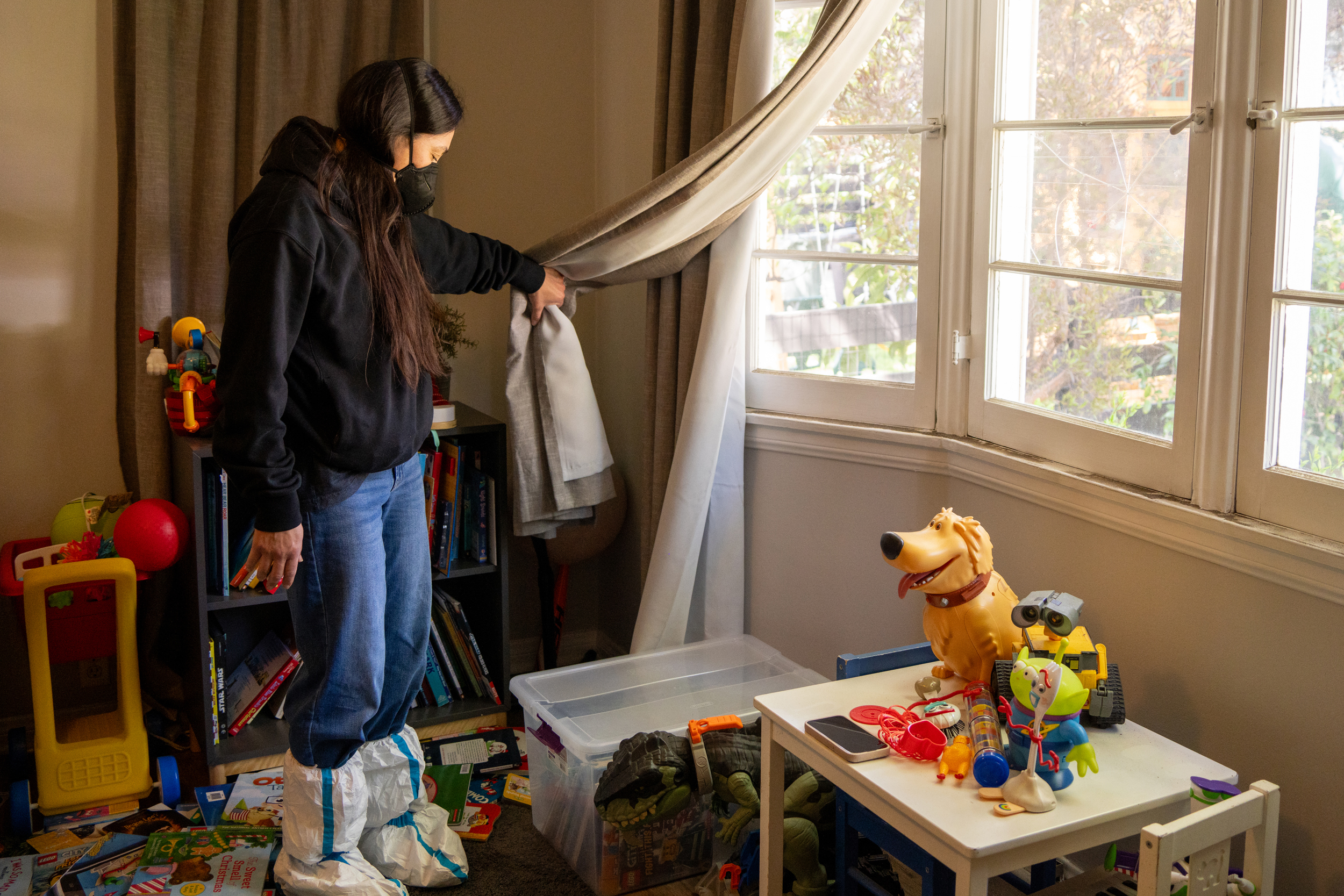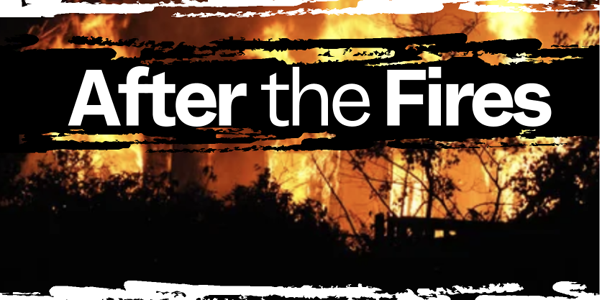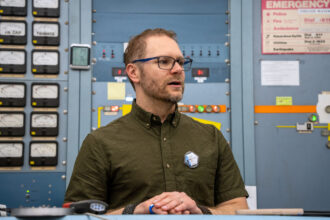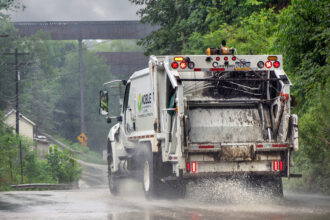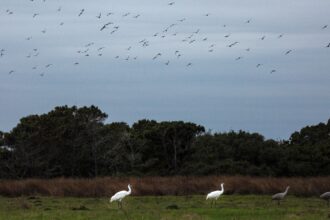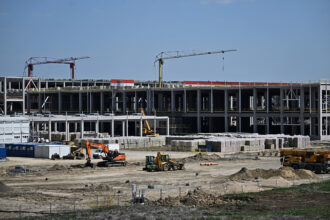After the Fires: Fourth in a series about health risks following the Los Angeles wildfires that destroyed Pacific Palisades and Altadena. This story was supported by the Pulitzer Center.
ALTADENA, Calif.—Her cozy blue bungalow was the one thing Adriana Valdez thought she didn’t have to worry about.
Her days were busy with work as a therapist and juggling care for her two neurodivergent children and her husband who has lymphoma. Home was their safe place.
“The house was a beacon of excitement, of confidence. Now it’s just grief and consumption,” Valdez said, referring to her efforts, months after the Eaton Fire, to return to the two-story home now contaminated with chemicals that she fears could harm her loved ones.
Her younger son, Max, 7, is severely autistic and nonverbal. His brother, Mateo, 12, has an anxiety disorder. Her spouse, Manfred Perera, is an entertainment lawyer who has a blood cancer that compromises his immune system.
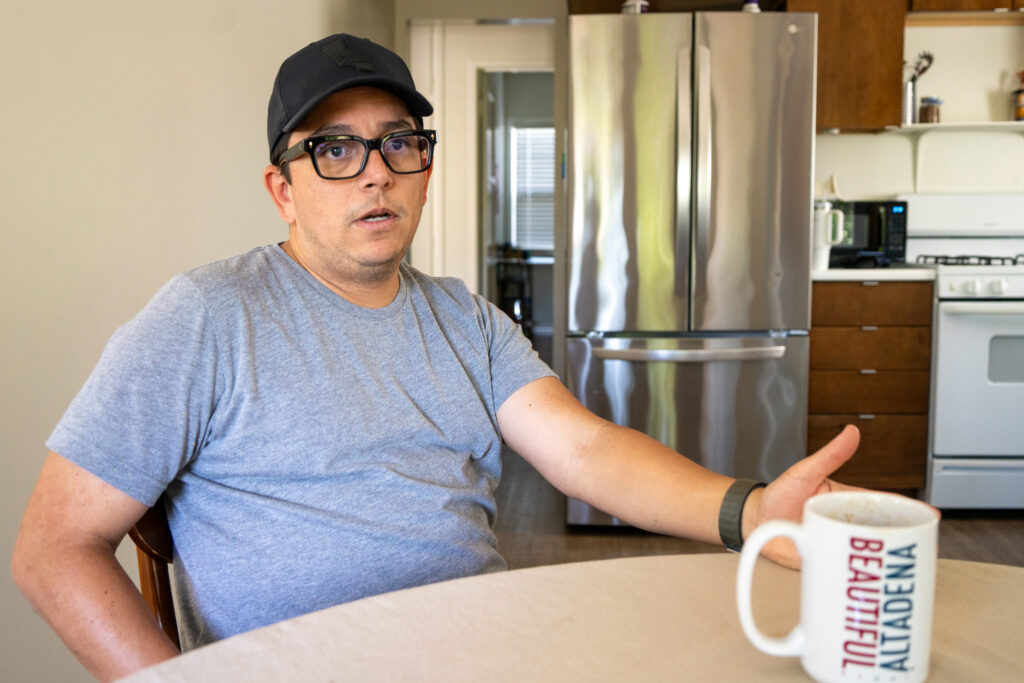
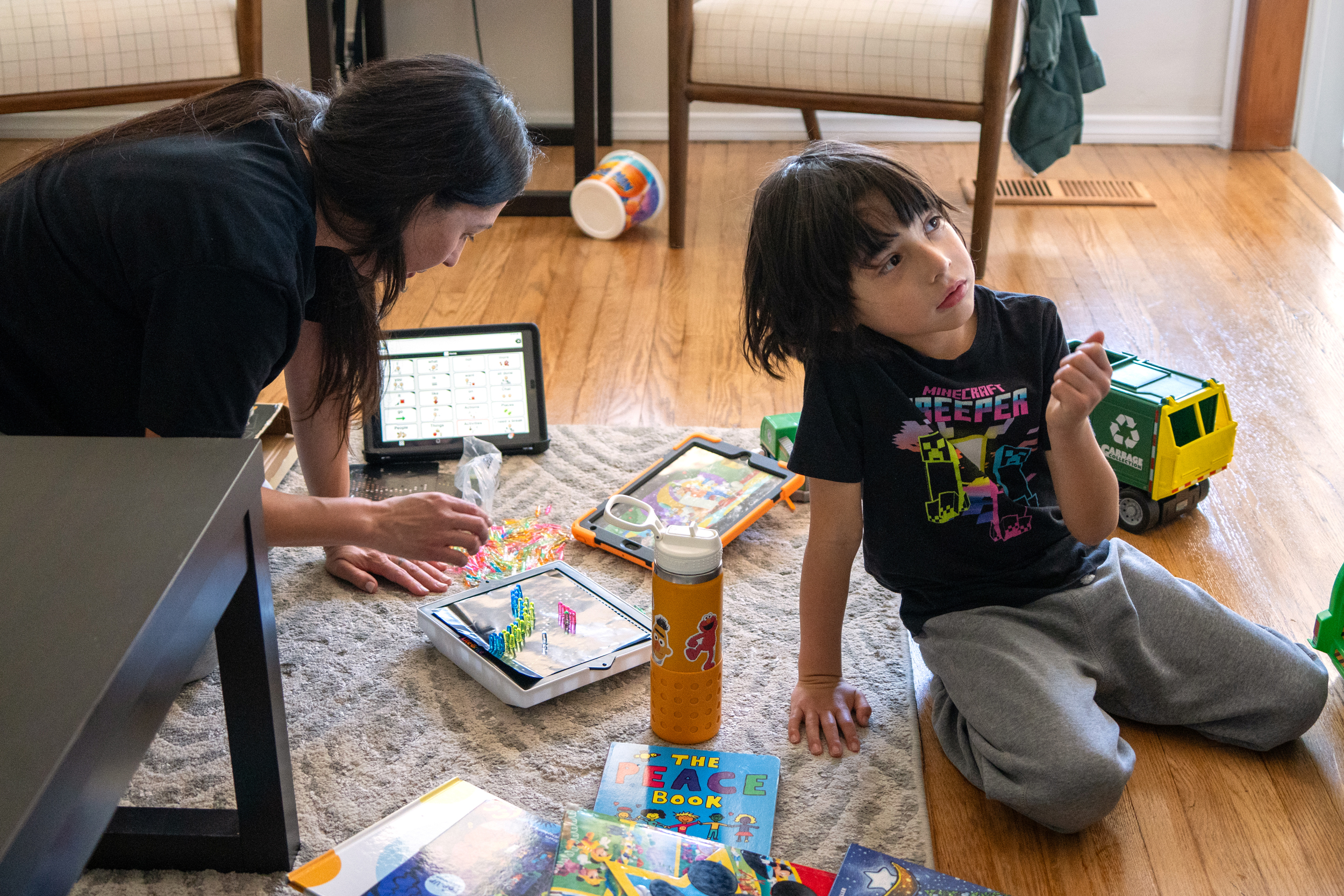
Since the fire, their lives have been upended. Max has regressed behaviorally and begun hitting himself and family. Mateo, displaced from his school, has become more fearful. Beyond physical challenges from lymphoma and the fire, Perera, the boys’ father, is finding life amid federal ICE raids in Los Angeles emotionally jarring.
Perera, 52, is an immigrant from Costa Rica who moved to the United States at the age of 11. He was used to some new beginnings. Still, nothing in the past 40 years prepared him for the lingering effects of the fire that torched Los Angeles County and terrified Altadena. “Every day we’re away is another day of uncertainty,” Perera said. “We can’t make decisions about schools, about work, about anything.”
A gigantic western sycamore tree still dominates the Valdez-Perera front yard on Parkman Street in this community just north of Pasadena.

Valdez loves the tree, with its large leathery leaves, that shaded the house long before the family moved in nearly 15 years ago. But as news reports on Jan. 5 and 6 warned that the city would be facing the strongest Santa Ana winds in more than a decade, the gargantuan sycamore began to sway. The Valdez-Perera family decided to evacuate to a hotel, taking enough clothes and food for a few days.
Nine months later, the family has no idea when they will be able to move back because of the chemical ruin inside. The tree and the house stand but Valdez fears that toxins from the urban interface fire—which burned through plastics, furniture, tars and oil-based products—are hazards for her sensitive sons.
For the Valdez-Perera family and others living with disabilities, the Eaton Fire is a continuing trauma. The unprecedented blaze has left them in a state-of-no-return and uncertain when or if normal daily routines will ever be restored. Recovery is not a simple matter.
“When you’re hit with both physical and psychological stressors, it’s a double event,” said Emily Diamond, a researcher at the nonprofit Wright Institute, who studies the intersection of environmental exposure, mental health and disability. “Mind is matter.”
For those already managing chronic illness or disability, the underlying stressor of loss of control adds weight to a backpack of losses carried by survivors. “Inflammation from these exposures is not just about cancer or asthma, it’s neurological, it’s everything,” Diamond said.
Valdez, 48, sees this, in herself and in her clients, although she has had less time for work as she deals with the after-fire realities of insurance claims and repairs. She is “not in a space” to work on disaster or immigration trauma right now, Valdez said, because the Eaton fire, though long extinguished, fills her waking hours with demands.
In many ways, she said, the family is still battling and fearing the blaze. “It consumes me,” she said. “I’m living it.”
Disabled More Likely to be Harmed
The Valdez-Perera family is not an outlier, and their story illustrates a pattern in climate disasters: disabled people are more likely to be harmed or displaced, less likely to receive timely aid and more likely to be permanently cut off from care.
As fires, floods and extreme weather events grow more frequent and intense, so do the risks and consequences for those living with chronic illness, mobility barriers or communication difficulties.
According to a 2023 National Council on Disability report, the global mortality rate of people with disabilities in natural disasters is up to four times higher than for people without disabilities. Disasters don’t just expose existing disparities. They deepen them.
Disabled people are more likely to face dangerous conditions if they evacuate, and less likely to return home. When they do, they often find their health has worsened, their supports have frayed, and their resilience—both physical and economic—has weakened, the report found.

Disaster researchers and advocates are beginning to assess the effect of what they call “disabling” or “disability multiplying” events. These are compounding blows in which one event primes the body and life circumstances for greater harm in the next. They aren’t isolated hits that can be patched over with time and aid.
Each wildfire, hurricane, or megastorm crisis can disable—temporarily or permanently—the people who survive it. The next disaster then lands on a larger pool of people who are more vulnerable. Research shows that 21 percent of displaced people with disabilities never return home, nearly four times the rate for non‑disabled residents.
In Altadena, the lack of warning or evacuation order likely intensified losses for disabled people. Lake Avenue was a dividing line for timely alerts and people who lived west of the street didn’t receive warnings until the fire had advanced into a flame storm with 100 mph winds. Of the 19 deaths from the Eaton fire, 18 were people who lived west of Lake Avenue.
More telling of the risk to vulnerable people: of the 19 deaths, 16 were disabled, elderly or had limited mobility. Questions remain whether lives could have been saved had first responders been deployed to evacuate the most vulnerable.
Kate Alexandria is one person who can describe—and still lives with the memory of—the chaos on Lake Avenue in January.
Her apartment was on the corner of Lake and Morada Place, the main thoroughfare dividing east and west Altadena, as the Eaton Fire spread. Flames were already visible on the street when a close friend arrived to help her evacuate. Alexandria, who has an autoimmune disorder, often relied on neighbor Jeremy Robertson for rides. She doesn’t drive and uses public transportation for her regular medical appointments.
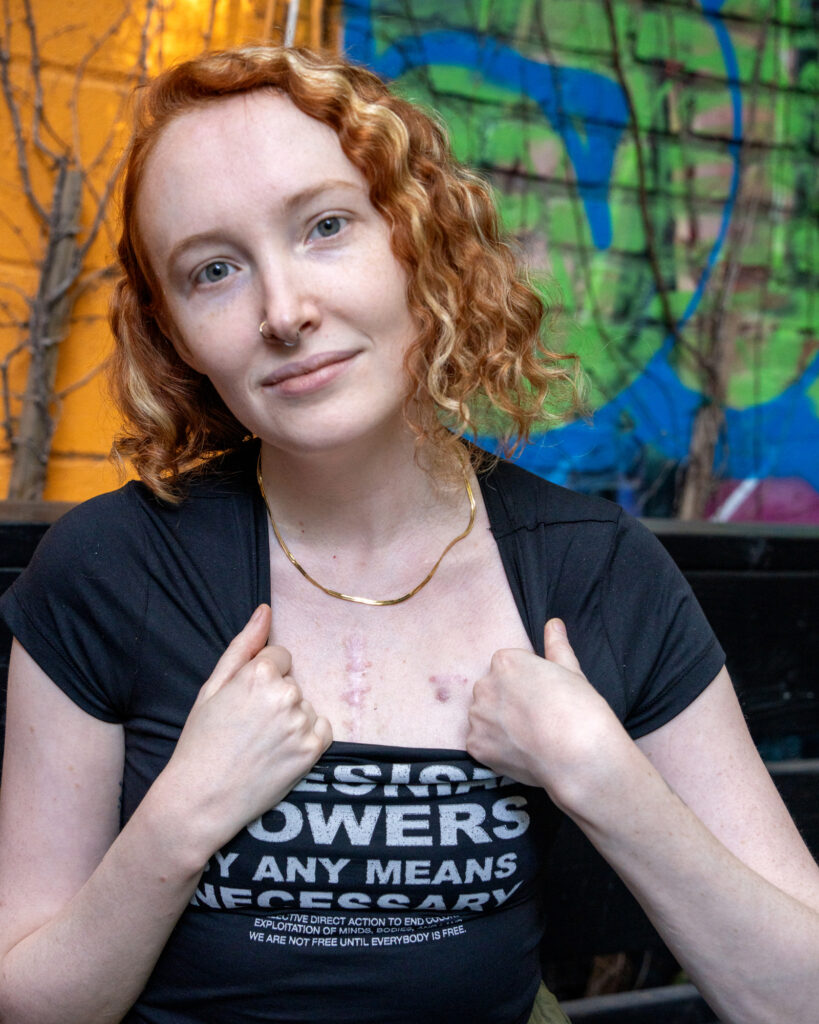
That day, the 28-year-old said she was in a “low-grade panic” when Robertson drove up. As Robertson wrangled Alexandria’s cat into a carrier, Alexandria grabbed various medical supplies but left behind a stash in her closet that she kept for emergencies. She figured she could easily fill prescriptions, and she wanted, quickly, to get out of harm’s way.
But Alexandria failed to grab a few medical devices she relies on, including one that measures how quickly her blood clots. That proved to be a mistake as Los Angeles reeled with road and business closures and traffic jams.
Alexandria stayed with Robertson in his home that night. The next morning, Robertson drove Alexandria to a weekly medical procedure, an infusion. By the time they tried to return, the National Guard had cut off the road to his home. Worse news was ahead: Alexandria found her apartment had been engulfed in flames while she was receiving her infusion.
Alexandria said without Robertson’s help, she and her cat likely would have died. “I wouldn’t have been able to get my cat out or anything, let alone myself…even if I was warned, I couldn’t have evacuated alone.”
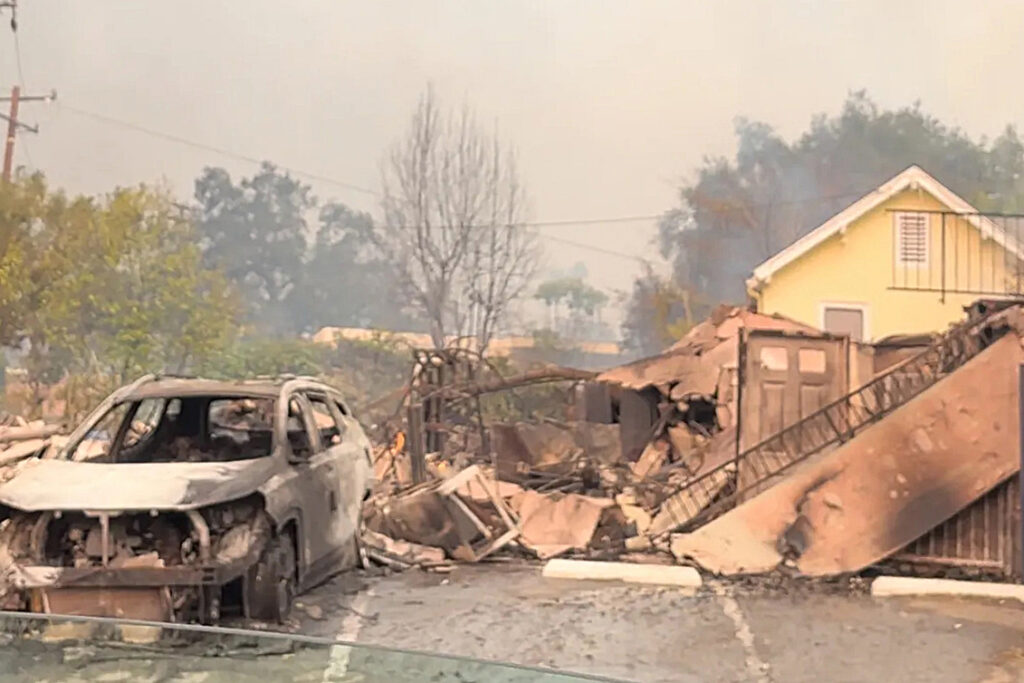
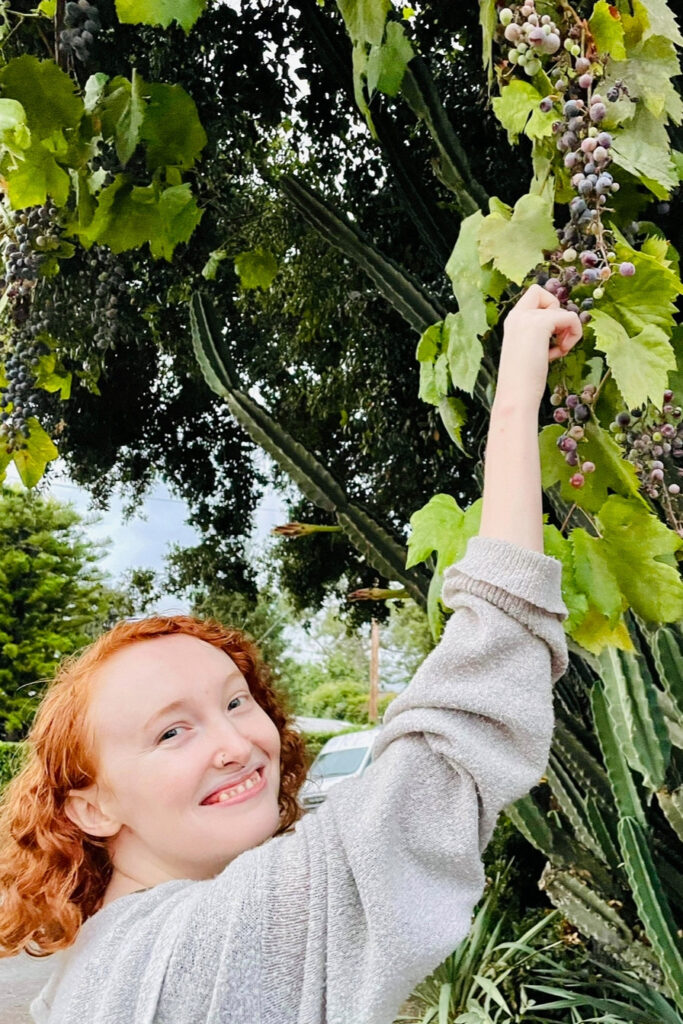
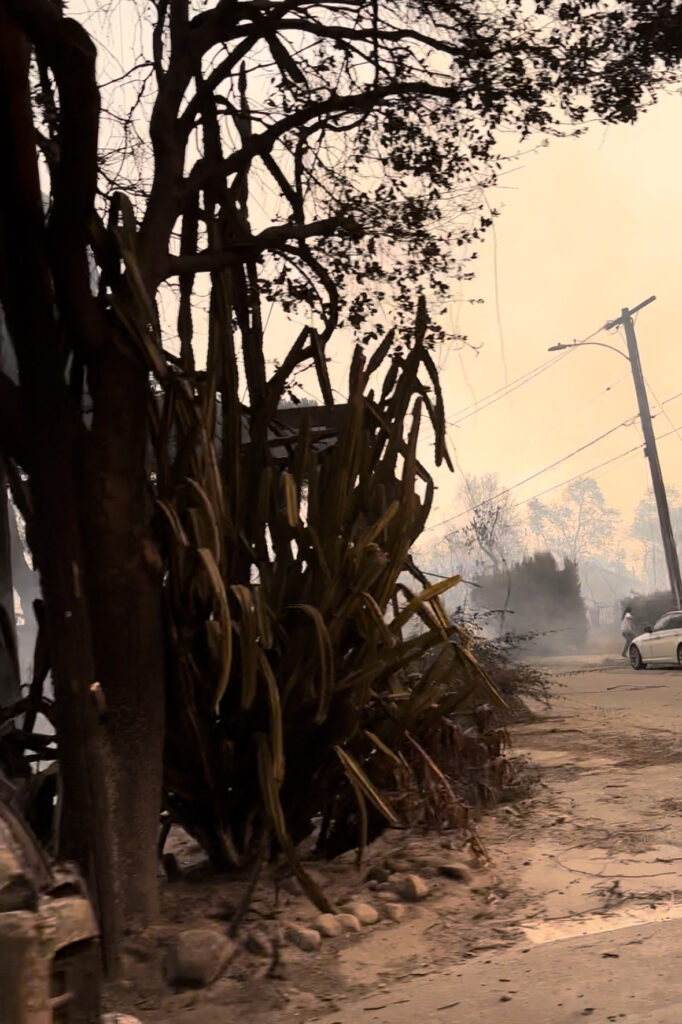
Kate Alexandria in her front yard before the Eaton Fire (left), and the charred remains of the plants left in its wake. Credit: Courtesy of Kate Alexandria
But the fires presented other risks tied to medical supply chains that have lingered for weeks. Her medications were suddenly hard to find. “Even if I’m able to get to a safe place…I’m at higher risk of stroke just by virtue of the disaster,” she said.
Alexandria went months at a time without her medical devices and had no way to check how quickly her blood clots or properly dose her blood thinners. In July, long after the January blaze, she replaced the equipment after a consultation with medical providers.
A petite transplant from the Pacific Northwest with bright red hair, Alexandria has survived the effect of a brutal trio of climate disasters—the Dixie Fire, Hurricane Helene and the Eaton Fire—over the past five years. Each has fractured her access to medical care, she said.
“Not only does being disabled make you several times more likely to die in a natural disaster,” she said, “but natural disasters also create new disabilities and exacerbate pre‑existing ones. Pretty much the opposite of ‘what doesn’t kill you makes you stronger.’”
The Most Vulnerable of Children
The Perera boys are living with the Eaton Fire every day.
The older boy, Mateo, was displaced from the family home and his school, St. Mark’s, which was destroyed in the fire. Classes were relocated to a nearby boarding school for the rest of the term. This year, Mateo has entered middle school, another new school, and his anxiety has worsened.
The 12-year-old visited the family home for the first time since the fires on Oct. 18. Valdez said Mateo decided the fear of forgetting his home outweighed his fear of contamination. Maryanne Wolf, a University of California-Los Angeles professor who studies climate resiliency and disability access, said Mateo was likely struggling with how to comprehend the wreckage. She does not consult or work directly with Mateo or his family, but she knows the signs of distress.
“Children with any kind of verbal communication issue … are experiencing loss, but can’t figure out or express their reaction to the new environment,” Wolf said. She is far more concerned for children like Max—Mateo’s younger brother who does not speak—who have limited ways to communicate sorrow or anger.
“When children with communication barriers experience something traumatic like a fire or being displaced from their home, they have no way to talk through what they are experiencing with parents or loved ones,” Wolf said. “Nonverbal children in particular are stuck trying to process their trauma in isolation so all that emotional upheaval can be turned inward.
“Sometimes this can manifest as developmental regression and other times this can present as behavioral regression or escalation” she said, like biting or self harm.
Wolf believes that one of the simplest interventions—better communication—is likely to have one of the largest impacts for disabled people. Some people just need better explanations of a calamity and some need ways of communication before the event. American Sign Language interpretation, plain‑language alerts, multilingual broadcasts and adapted weather radios to reach people with sensory or cognitive disabilities as the disaster occurs and in the weeks after would be valuable, she said.
The Valdez-Perera family has experienced this firsthand. Among the legacies of the Eaton fire has been coming to terms with how Max has absorbed the big changes in his life and how he has coped with the upheaval. “He’s hitting us and himself, refusing to go anywhere but home. These behaviors weren’t there before the fire,” Valdez said.
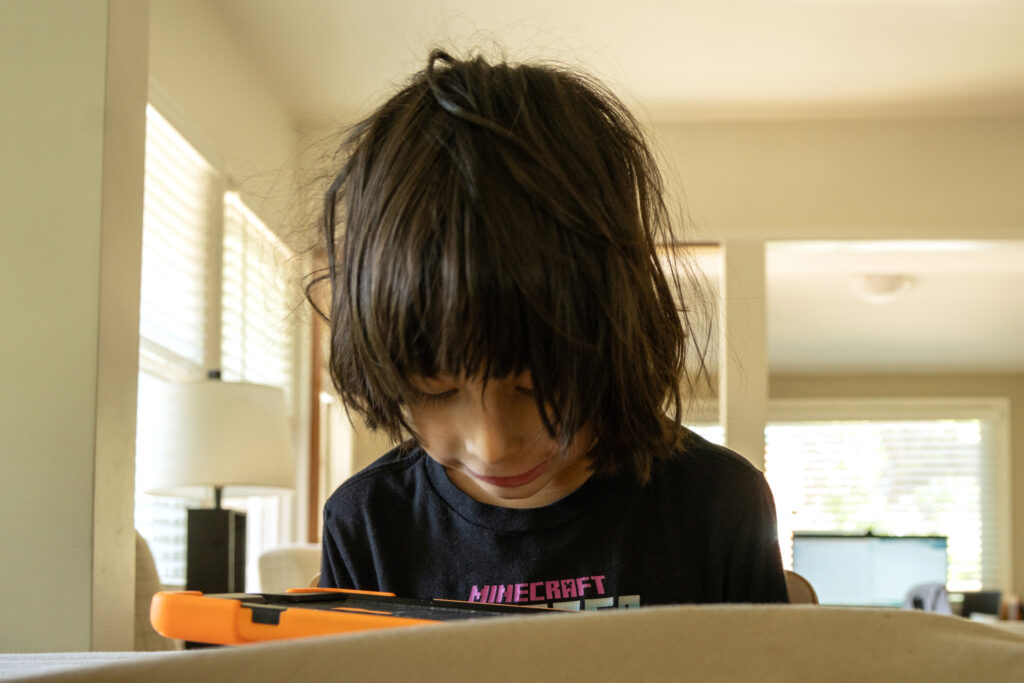
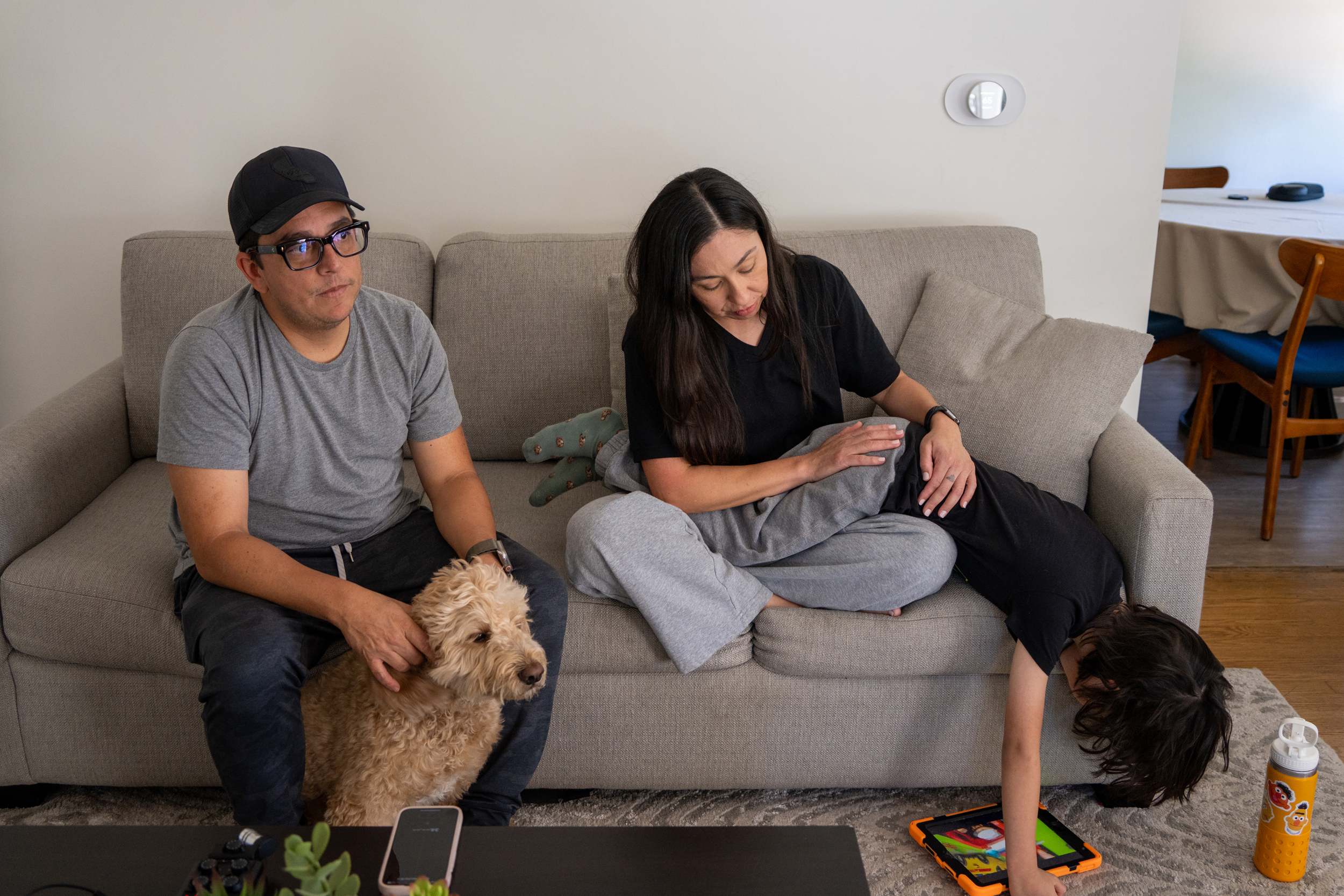
The most damaging gap has been in special education and disability support services for her younger son, she added. After the Eaton Fire, her family was transferred between regional centers for care and counseling.
“They told us it would take two to three months because they were understaffed and underfunded,” she said. “Meanwhile, I’m losing income and scrambling for in‑home support that I might not even qualify for, because of our income. It’s a lot of barriers.”
Their services for Max were further delayed when the coordinator they were initially assigned to left her job, Valdez said. This month, more than nine months after the fire, Max was finally assigned a coordinator at the resource center. Max’s school offers a half-day session, meaning the family has been scrambling to pick him up at 1 p.m., smack in the middle of Valdez’s and Perera’s workday. Until they can get the situation with the resource center sorted, Valdez and Perera have decided to hire an after-school caretaker for Max.
“Science Is Still Catching Up”
Alexandria, who works as a grant and communications writer for nonprofits, receives disability benefits for smoke harm from the Eaton fire. She said a pattern of disasters in the last decade has become disruptive to her already-fragile access to medical care.
“It strikes me as a massive problem that we don’t even understand how bad the impact has been since 2018,” Alexandria said about the broader health risks. “Because science is still catching up. Over 75 percent of California’s most destructive fires have happened since 2015—many since 2020,” she said, referring to recent press reports. “And we’re still largely in the dark about the scale of the health consequences.”
“I want to know: if this kills me, who is responsible for my death?” Alexandria wrote in a follow-up email. “Who can be held accountable so that this doesn’t happen to other people?”
Local authorities reported 19 fatalities from the Eaton Fire. But a JAMA research letter published in August 2025 estimates that at least 440 excess deaths occurred in Los Angeles County during the fires in January.
The study compared weekly mortality rates from Jan. 5 to Feb 1 to pre-pandemic trends in the same months in 2018, 2019 and 2024. The study found that wildfire disasters leave a broad wake of harm, especially for people with heart, lung, or immune conditions. Alexandria has found that climate disasters can sever essential supply chains for medications and specialized equipment. Even events far from home can trigger a personal emergency, she said.
In September 2024, Hurricane Helene slammed into the southeast United States. Alexandria was nowhere near the storm that devastated North Carolina, but a Baxter medical supply plant that produces sterile saline and IV infusion supplies was in its path. The hurricane crippled operations and created a nationwide shortage.
“I couldn’t get the supplies I needed for weeks,” Alexandria said. “It wasn’t even about the drug itself—it was the bags, the tubing, the saline. Without those, the medication just sits in a vial, useless.”
“People don’t realize how interconnected medical supply chains are … Hurricane Helene took out the saline factory, and suddenly my infusion therapy was cut by 75 percent.”
The Valdez-Perera Perils
Wildfire smoke is not just wood ash. It’s a chemical stew with fine particulate matter, volatile organic compounds (VOCs), heavy metals and combustible plastics, electronics and building materials. The mixture from an urban interface fire is far more toxic than the smoke from wildlands alone, as Valdez and Perera have learned.
Since the fire, Valdez and Perera have hired an attorney to deal with home insurance negotiations. The insurer State Farm has offered $20,000 for personal property losses and disposal, but most if not all of that money will pay for a professional “pack out,” a safe disposal of the family’s contaminated belongings, they said.

The family also has to replace soft goods too big to fit in a washing machine. That includes sofas, carpets and mattresses. The heat of the fire damaged other materials in the house and the family was advised that they need lead abatement throughout the structure. Testing from the L.A. Fire Health Consortium, an assessment effort formed in late January, found that the air inside the Valdez-Perera home has elevated levels of particulate matter and VOCs compared with homes further from the burn zone.
These pollutants can lodge deep in the lungs, irritate the respiratory tract and, in the case of certain VOCs, contribute to cancer risk, liver or kidney damage and neurological effects.
For now the Valdez-Perera home remains in stasis, untouched for the last 10 months. It was damaged from top to bottom. Shingles were burned across the roof and they can’t find suitable replacements. The attic insulation was saturated with VOCs and other contaminants. The HVAC system needs to be replaced. The snaking ductwork in its system makes it near impossible to clean and fully decontaminate, the family has been told.
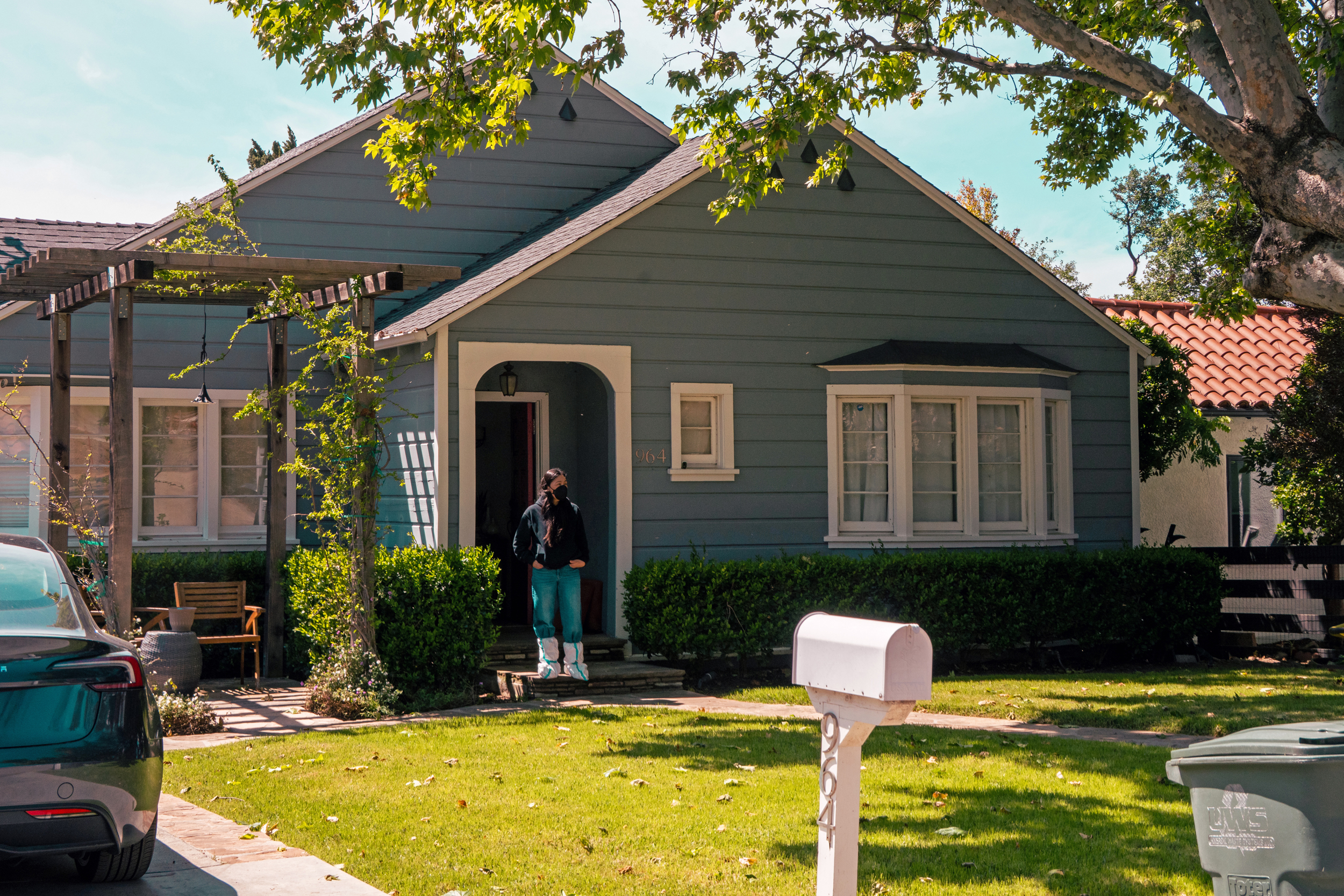


The view from the Valdez-Perera family’s front door now looks out at an empty lot where her neighbor’s house once stood.
So far an ongoing ash analysis by University of California–Davis researchers, led by air pollution scientist Nicholas Spada, has delivered the most alarming numbers about the house. Spada provided a report to the Valdez-Perera family from samples of ash collected inside and outside the premises.
The ash, from their front stoop, stairs and kitchen window, found lead levels more than double the federal EPA residential soil screening limit (170–173 ppm vs. 80 ppm) and arsenic levels that were over 200 times the EPA residential screening level for child ingestion (15–19 ppm vs. 0.07 ppm). Cadmium levels were at or above California’s health‑protective screening threshold (1.4–1.9 ppm vs. 1.7 ppm).
“These are well‑known neurotoxic and carcinogenic elements, detected above both the soil screening level and background concentrations from uncontaminated fire ash,” Spada wrote in the report.
For the Valdez-Perera family, these aren’t abstract chemical names. They are risks and potential triggers for conditions that already trouble their medically vulnerable brood. Perera has a weakened immune system because of his lymphoma. Mateo’s anxiety leads to gastrointestinal issues. Max, the son with nonverbal autism, has a habit of touching surfaces and putting his hands in his mouth.
This story is funded by readers like you.
Our nonprofit newsroom provides award-winning climate coverage free of charge and advertising. We rely on donations from readers like you to keep going. Please donate now to support our work.
Donate Now“People with autism process [chemicals in plastics] and other contaminants more slowly,” Valdez said. “They stay in their bodies longer. My son can’t tell me if he’s in pain or having trouble breathing. It’s a guessing game.”
The insurance company refused to cover the full cost a deep clean, offering a fraction of what’s needed, the couple said. They disputed the company’s estimate. An adjuster visited their home last week to conduct a new assessment. Valdez and Perera are awaiting the results.
“We still have to figure out what the toxicity reports come back with as far as lead and other contaminants in the soil,” Perera said. “Even then I don’t know how safe it is for us to go back.”
Scarce Data on Disability Needs
Federal and state systems define disability as a special category of need. Data is scarce and fragmented. Infrastructure investments often ignore accessibility. And the laws meant to protect disabled people in emergencies are enforced so rarely, according to Diamond of the Wright Institute, that they function more as aspirations than guarantees.
For Valdez and Perera, disability provisions provide some stability and community—and the security of knowing that if another disaster comes, they won’t be thrust to the brink of homelessness. They hope their children won’t have to grow up in a world where safety is a privilege or health risks linked to disasters are yet to be recognized.
The evolving science of disasters and health risks may be on their side.
A 2023 study published in the peer-reviewed journal Science Advances found that wildfire smoke in California led to over 50,000 deaths between 2008 and 2018—most from heart and lung disease—with economic losses estimated at over $400 billion.
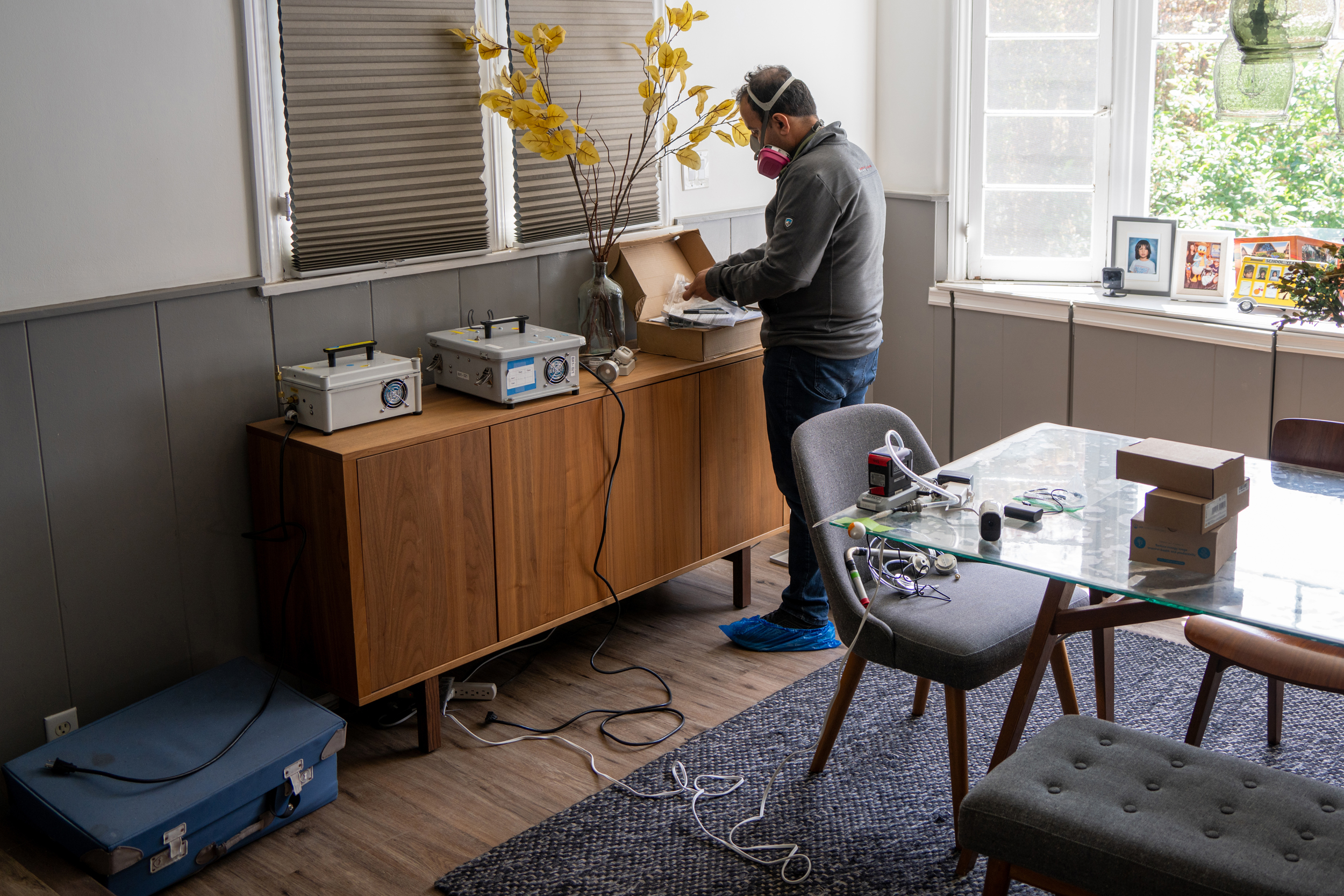
A 2024 study in Nature on the long-term effects of cyclones on health and life expectancy, provides further insight. Disasters don’t just kill in the moment—they leave a long shadow, the study found.
Researchers reviewed data among populations affected by hurricanes and tropical storms in the United States and found that, for years after, populations suffered “indirect deaths” that were “substantially higher than official counts of mortality occurring during the geophysical event.”
The researchers examined data from 1930 to 2015 and found delayed effects and risks lasted for up to 15 years in the population and included economic loss, disrupted care, and stress. The researchers said their analysis found deaths—or what they called an “undocumented mortality burden”—rose as much as 5.1 percent.The study also shows inequities widen after disasters. Infants and Black people faced the steepest long-term risks.
Throughout 2025, some of the same patterns are emerging in Los Angeles and disabled people are among the disadvantaged survivors. In other words, the official health risks and fatalities that are now known in Altadena and beyond may be a sliver of the true toll.
Accessible Infrastructure
Diamond of the Wright Institute said the Eaton Fire and its aftermath underscores the need for medical continuity for disabled people as well as a plan for evacuation as climate change intensifies the frequency and intensity of some disasters.
“Preparedness is not just the responsibility of individual families. Communities can recognize that disaster risks are rising,” she said, and governments and neighborhoods are in the position to provide better protections for the most vulnerable.
Emergency management agencies have long designed systems with an imaginary “average” resident in mind: someone who can self‑evacuate, communicate clearly, tolerate disrupted routines and shelter in a standard facility. For disabled people, those assumptions can be fatal.
“They talk about inclusive planning, but it’s almost always symbolic,” Alexandria said. “We’re still excluded from the actual decision‑making, and that’s why we see these same failures over and over.”
About This Story
Perhaps you noticed: This story, like all the news we publish, is free to read. That’s because Inside Climate News is a 501c3 nonprofit organization. We do not charge a subscription fee, lock our news behind a paywall, or clutter our website with ads. We make our news on climate and the environment freely available to you and anyone who wants it.
That’s not all. We also share our news for free with scores of other media organizations around the country. Many of them can’t afford to do environmental journalism of their own. We’ve built bureaus from coast to coast to report local stories, collaborate with local newsrooms and co-publish articles so that this vital work is shared as widely as possible.
Two of us launched ICN in 2007. Six years later we earned a Pulitzer Prize for National Reporting, and now we run the oldest and largest dedicated climate newsroom in the nation. We tell the story in all its complexity. We hold polluters accountable. We expose environmental injustice. We debunk misinformation. We scrutinize solutions and inspire action.
Donations from readers like you fund every aspect of what we do. If you don’t already, will you support our ongoing work, our reporting on the biggest crisis facing our planet, and help us reach even more readers in more places?
Please take a moment to make a tax-deductible donation. Every one of them makes a difference.
Thank you,

